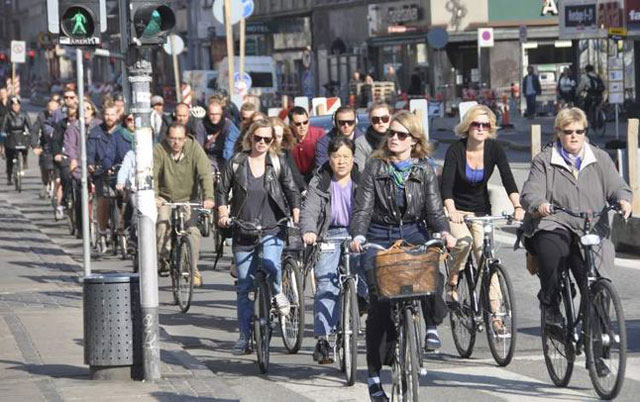
2Home to inspiring modern architecture, set within a dense and vibrant urban context, the most significant impression any visitor has of the Scandinavian capital is an overwhelming presence of bicycles.
In Copenhagen, 37 per cent of the population ride their bikes to work every day. With a vast, integrated system of separated lanes and dedicated lights, rush-hour traffic can often be heavier for cyclists than motorists. The system is so safe only 15 per cent of Danes choose to wear a helmet.
During a recent architectural pilgrimage to the Nordic city, I was lucky enough to visit prominent Danish architect and urban planner Jan Gehl. Having written several influential books on the design of livable cities, he has been instrumental in establishing Copenhagen's bike culture. In our discussion, Gehl lamented the lack of cycling infrastructure in most Canadian cities and cited the significant social and economic benefits it can have. He referred to a study commissioned by the mayor of Copenhagen indicating that when taking all factors into account, every kilometre ridden on a bike saves Danish society 25 cents and every kilometre travelled by car costs them 16 cents.
In Winnipeg, the first steps toward implementation of an active transportation network have largely been focused on encouraging healthy lifestyle choices, but expanding on Gehl's business case for an urban cycling infrastructure might be a valuable strategy to galvanize government and public support for its continued development.
The most easily quantifiable economic impact of active transportation is realized through individual savings. Car ownership is the second-greatest expense in a typical Canadian household, costing on average $7,500 annually, per vehicle. When alternate transportation options are provided, costs such as fuel, parking and maintenance can be greatly reduced. If a household is able to eliminate one car, these savings can be substantial.
Developers across Canada are realizing more compact, walkable neighbourhoods that are integrated into an overall urban active-transportation network are seen to provide a higher quality of life, are more desirable and as a result command greater property values and tax revenue.
Cities that struggle with infrastructure-funding deficits can look to an improved cycling network as a means of reducing some of that pressure on local government. A small shift in vehicle use can have a disproportionate impact on the need for increased road construction. According to the U.S. Federal Highway Administration, by decreasing the number of cars on a high volume urban street by only three per cent, peak rush hour congestion can be reduced by nearly 30 per cent. With the cost of road construction being more than 10 times that of segregated bike lanes, significant economic savings can be realized by enticing more commuters to choose alternate means of transportation.
Implementation of an active transportation network has shown to be an effective government policy for targeting employment growth. Bike-lane construction is labour-intensive rather than equipment- and material-intensive. A study done in Baltimore revealed that for every dollar invested in developing segregated bike lanes, more than twice as many jobs were created when compared to road construction.
An active-transportation network can also be good for business. When compared to motorists, cyclists and pedestrians spend more money in local and small retail establishments. Healthier employees can decrease absenteeism and improve job satisfaction, while reducing the burden on our health-care system.
Cyclists contribute to the creation of an active street culture, which improves neighbourhood vibrancy and safety, in turn promoting increased spending and economic growth. As urban quality improves, the livability and public image of the city as a whole is enhanced, becoming more attractive to investment, tourism and immigration.
The cost of implementing an urban active-transportation network is not unattainable when weighed against these economic benefits. It is estimated the City of Portland, considered the most bike-friendly municipality in North America, where six per cent of commuters are cyclists (under two per cent in Winnipeg), could replace its entire existing cycling infrastructure for only $60 million.
That represents the cost of widening less than two kilometres of Kenaston Boulevard.
Winnipeg will likely never be Copenhagen, but its urban structure makes it a favourable candidate for an effective cycling network. With 72 per cent of the population living with 10 kilometres of downtown and a highly centralized workforce, the median commute is only 6.1 kilometres, a much shorter distance than in other Canadian cities.
There is a pervasive attitude in Winnipeg that our harsh winters make these economic benefits less attainable and investment in active transportation less valuable. When speaking with Jan Gehl, I asked him how he would respond to that criticism. He replied by saying in Canada, we focus so much on being protected on the bad days it often keeps us from taking full advantage of many good days. He wants us to shift our priority and look at the glass as being half full, recommending we take care of the 250 good days first and then find a balance for the others.
He makes a good point.
Brent Bellamy is senior design architect for Number Ten Architectural Group.
Republished from the Winnipeg Free Press print edition October 1, 2012 B5